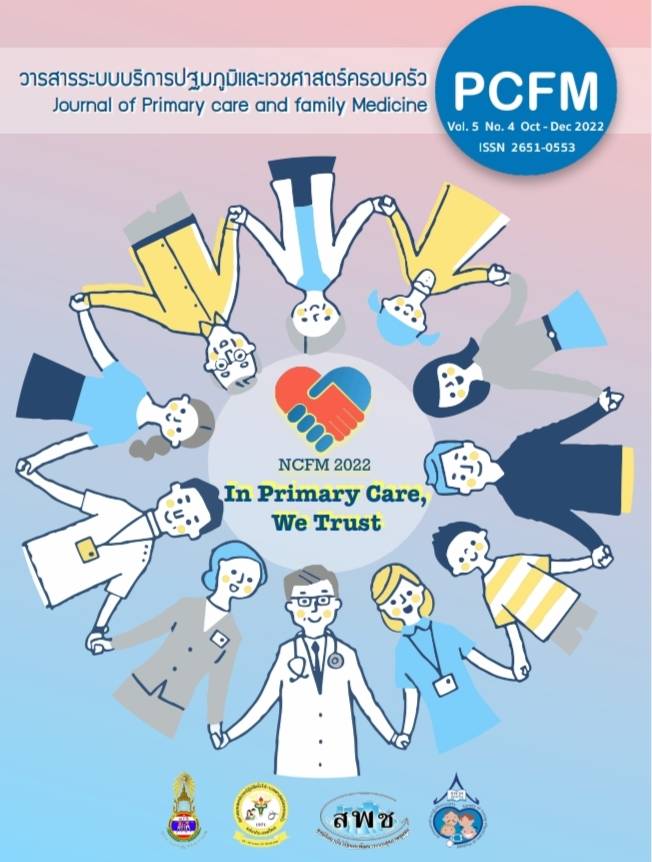การดูแลผู้สูงอายุแบบบูรณาการในชุมชน ประเทศญี่ปุ่น
Main Article Content
บทคัดย่อ
ประเทศญี่ปุ่น เป็นประเทศที่ก้าวเข้าสู่สังคมผู้สูงอายุโดยสมบูรณ์เป็นประเทศแรก ๆ ของโลก การเพิ่มขึ้นของสัดส่วนประชากรผู้สูงอายุต่อประชากรวัยทำงานทำให้เกิดความกังวลใจในเรื่องของการดูแลสุขภาพผู้สูงอายุ การนำผู้สูงอายุให้มาอาศัยอยู่ในสถานดูแลผู้สูงอายุอาจไม่ใช่คำตอบของการดูแลในบริบทที่ประชากรผู้สูงอายุมีจำนวนมากและบุคลากรที่จะให้การดูแลมีสัดส่วนที่น้อย ทั้งปัญหาการขาดแคลนทรัพยากรต่าง ๆ ยังตามมา ดังนั้น การจัดระบบการดูแลสุขภาพผู้สูงอายุในชุมชนอย่างเหมาะสมและยั่งยืนจึงเป็นสิ่งที่จำเป็นมาก และการบูรณาการกับภาคส่วนอื่นทั้งภาครัฐและเอกชน ยังเป็นสิ่งที่ช่วยส่งเสริมการดูแลสุขภาพผู้สูงอายุให้มีประสิทธิภาพมากยิ่งขึ้น การบูรณาการการดูแลผู้สูงอายุในชุมชนนี้ ไม่ได้เพียงเป็นการลดปัญหาการขาดแคลนทรัพยากรต่าง ๆ เท่านั้น แต่ยังเป็นการสร้างเสริมสุขภาพ และเป็นการป้องกันการเกิดโรคและความเจ็บป่วยที่อาจจะเกิดขึ้นในผู้สูงอายุได้อีกด้วย ทั้งยังเป็นการช่วยเหลือครอบครัวและผู้ดูแลของผู้สูงอายุ ลดการเกิดความรู้สึกว่าการให้การดูแลนั้นส่งผลกระทบต่อร่างกาย จิตใจของตนเอง เกิดความเหนื่อยล้าในการดูแล ซึ่งเป็นการส่งเสริมความสัมพันธ์ในครอบครัวอีกด้วย
Article Details

อนุญาตภายใต้เงื่อนไข Creative Commons Attribution-NonCommercial-NoDerivatives 4.0 International License.
เนื้อหาและข้อมูลในบทความที่ลงตีพิมพ์ในวารสาร PCFM ถือเป็นข้อคิดเห็นและความรับผิดชอบของผู้เขียนบทความโดยตรง ซึ่งกองบรรณาธิการวารสารไม่จำเป็นต้องเห็นด้วยหรือร่วมรับผิดชอบใด ๆ
บทความ ข้อมูล เนื้อหา รูปภาพ ฯลฯ ที่ได้รับการตีพิมพ์ลงในวารสาร PCFM ถือเป็นลิขสิทธิ์ของวารสาร PCFM หากบุคคลหรือหน่วยงานใดต้องการนำทั้งหมดหรือส่วนหนึ่งส่วนใดไปเผยแพร่ต่อหรือเพื่อกระทำการใด ๆ จะต้องได้รับอนุญาตเป็นลายลักษณ์อักษรจากวารสาร PCFM ก่อนเท่านั้น
เอกสารอ้างอิง
Statistics Bureau Ministry of Internal Affairs and Communications Japan. Statistical Handbook Of Japan 2019. Bureau Statistics Ministry of Internal Affairs and Communications, Japan, editors. Tokyo: Statistics Bureau Ministry of Internal Affairs and Communications Japan; 2019.
Olivares-Tirado P, Tamiya N, Kashiwagi M. Effect of in-home and community-based services on the functional status of elderly in the long-term care insurance system in Japan. BMC Health Serv Res. 2012; 12(1): 1–10.
Tokudome S, Hashimoto S, Igata A. Life expectancy and healthy life expectancy of Japan: the fastest graying society in the world. BMC Res Notes. 2016; 9(1): 1–6.
Joshua L. Aging and Long Term Care Systems: A review of finance and Government Arrangments in Europe, North America and Asia-Pacific. Social Protection & Labor. Report No.1705. United states: World Bank Group; 2017.
Morikawa M. Towards community-based integrated care: Trends and issues in Japan’s long-term care policy. Int J Integr Care. 2014; 14(JAN/MAR): 1–10.
Frances W, Caren J. F, Scott S, Ruth G-M, Reiko H, Yomei N, et al. Japanese elders’ perceptions of the impact of Home and Community based Long Term Care services on quality of life and independence. ejcjs 2013; 13(3).
Mitchell OS, Piggott J, Shimizutani S. AGED-CARE SUPPORT IN JAPAN: PERSPECTIVES AND CHALLENGES. Benefits Q. 2006; 22(1): 7-18.
OECD. Long-term Care. Organisation for Economic [Internet]. 2019 [cited 2021 Nov1]. Available from: https://www.oecd.org/els/health-systems/long-term-care.htm
OECD. OLD-AGE DEPENDENCY RATIO Key results. Pension at a Glance 2017: 122-3.
OECD/EU. A Good Life in Old Age? Monitoring and Improving Quality in Long-term Care. In: OECD Health Policy Studies. Paris: OECD Publishing; 2013.
OECD. Old-age dependency ratio. In: Pensions at a Glance 2017: OECD and G20 Indicators [Internet]. Paris: OECD Publishing; 2017 [cited 2019 Nov 1].
Ohwa M, Chen LM. Balancing Long-term Care in Japan. J Gerontol Soc Work. 2012; 55(7): 659–72.
Sakamoto H, Rahman M, Nomura S, Okamoto E, Koike S, Yasunaga H, et al. Japan Health System Review. New Delhi: World Heal Organ Reg Off South-East Asia; 2018.
Natasha C, Sophie C-C, Nina H. What can England learn from the long-term care system in Japan? United Kingdom: Research Report, Nuffield Trust; 2018.
Kondo A. Migration and Law in Japan. Asia Pacific Policy Stud. 2015; 2(1): 155–68.
Fern AK. Benefits of Physical Activity Programming Modifications to Enhance the Exercise Experience. ACSM’s Heal Fit. 2000; 13(5): 12–6.
Gruenenfelder-Steiger AE, Katana M, Martin AA, Aschwanden D, Koska JL, Kündig Y, et al. Physical activity and depressive mood in the daily life of older adults. GeroPsych J Gerontopsychology Geriatr Psychiatry. 2017; 30(3): 119–29.
Blumenthal JA, Babyak MA, Moore KA, Craighead WE, Herman S, Khatri P, et al. Effects of exercise training on older patients with major depression. Arch Intern Med. 1999; 159(19): 2349–56.
Coulter A, Entwistle VA, Eccles A, Ryan S, Shepperd S, Perera R. Personalised care planning for adults with chronic or long-term conditions. Cochrane Database Syst Rev. 2015 Mar 3; 2015(3): CD010523.
Saito M. Current issues regarding family cargiving and gender equality in Japan: male caregivers and the interplay between caregiving and masculinities. Japan labor Rev. 2017; 14(1): 92–111.
Ishii K. Informal care and employment status of Japanese middle aged women : a study using JSTAR. Tokyo; JSTAR datasets: 2015.
van de Ree CLP, Ploegsma K, Kanters TA, Roukema JA, De Jongh MAC, Gosens T. Care-related Quality of Life of informal caregivers of the elderly after a hip fracture. J Patient-Reported Outcomes. 2018; 2(1): 23.
Shimizutani S. The Future of Long-term Care in Japan. Asia-Pacific Rev. 2014; 21(1): 88–119.
Metzelthin SF, Verbakel E, Veenstra MY, Van Exel J, Ambergen AW, Kempen GIJM. Positive and negative outcomes of informal caregiving at home and in institutionalised long-term care: A cross-sectional study. BMC Geriatr. 2017; 17(1): 1–10.
Haya MAN, Ichikawa S, Wakabayashi H, Takemura Y. Family caregivers’ perspectives for the effect of social support on their care burden and quality of life: A mixed-method study in rural and sub-urban central Japan. Tohoku J Exp Med. 2018; 247(3): 197–207.
Aihara Y, Maeda K. National dementia supporter programme in Japan. Dementia. 2021; 20(5): 1723–8.
Lee S, Saito T, Takahashi M, Kai I. Volunteer participation among older adults in Japan: An analysis of the determinants of participation and reasons for non-participation. Arch Gerontol Geriatr. 2008; 47(2): 173–87.
Kobayashi E, Sugihara Y, Fukaya T, Liang J. Volunteering among Japanese older adults: how are hours of paid work and unpaid work for family associated with volunteer participation? Ageing Soc 2019; 39(11): 2420–42.


